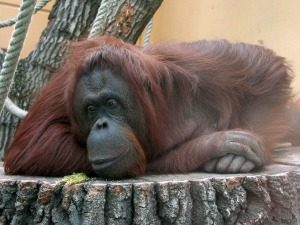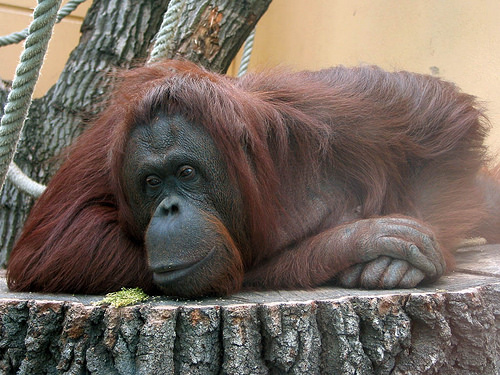
DURHAM UNIVERSITY—An adolescent orangutan called Rocky could provide the key to understanding how speech in humans evolved from the time of the ancestral great apes, according to new research.
In an imitation “do-as-I-do” game, eleven-year-old Rocky, who was eight at the time of the research, was able to copy the pitch and tone of sounds made by researchers to make vowel-like calls.
The discovery, led by Dr Adriano Lameira of Durham University, UK, shows that orangutans could have the ability to control their voices.
It might answer the argument about whether or not spoken language stemmed from early human ancestors.
Previously it was thought that great apes – our closest relatives – could not learn to produce new sounds and because speech is a learned behaviour it could not have originated from them.
The findings are published today (Wednesday, July 27) in the journal Scientific Reports.
Rocky was studied at Indianapolis Zoo, Indiana, USA, where he is currently housed, between April and May 2012, and all steps were taken to ensure his routine and environment were not disrupted.
During the study, a researcher made random sounds with variations in the tone or pitch of her voice which Rocky then mimicked.
The research team compared these sounds against the largest available database of orangutan calls collected from over 12,000 hours of observations of more than 120 orangutans from 15 wild and captive populations.
They were able to conclude that the sounds made by Rocky were different compared to the sounds on the database, showing that he was able to learn new sounds and control the action of his voice in a “conversational” context.
Dr Lameira, who was not a member of Durham University staff at the time of the research but joined the Department of Anthropology in 2015, said: “It’s not clear how spoken language evolved from the communication systems of the ancestral great apes.
“Instead of learning new sounds, it has been presumed that sounds made by great apes are driven by arousal over which they have no control, but our research proves that orangutans have the potential capacity to control the action of their voices.
“This indicates that the voice control shown by humans could derive from an evolutionary ancestor with similar voice control capacities as those found in orangutans and in all great apes more generally.
“This opens up the potential for us to learn more about the vocal capacities of early hominids that lived before the split between the orangutan and human lineages to see how the vocal system evolved towards full-blown speech in humans.”
________________________________________
Image courtesy Zyance, Wikimedia Commons
_____________________________________________________
The research also involved the Pongo Foundation (Netherlands); Max Planck Institute for Evolutionary Anthropology (Germany); Liverpool John Moores University (UK); University of Amsterdam (Netherlands); Indianapolis Zoo (USA); George Mason University (USA); Indiana University (USA).
It builds on a previous study led by Dr Lameira when he was based at the University of Amsterdam.
In that study, published in January 2015, it was reported that a female orangutan called Tilda at Cologne Zoo, in Germany, was able to make sounds comparable to human consonant and vowel-like calls at the same rhythm and pace as human speech.
Source: News release of Durham University
_____________________________________________________

______________________________________________
Travel and learn with Far Horizons.
____________________________________________
This richly illustrated issue includes the following stories: Recent findings shedding new light on the whereabouts of the remains of Philip of Macedon, father of Alexander the Great; how an archaeologist-sculptor is bringing bones of the dead back to life; archaeologists uncovering town life at the dawn of civilization; an exclusive interview with internationally acclaimed archaeologist James M. Adovasio about what makes the Meadowcroft Rockshelter prominent in the ongoing search for the first Americans; what archaeologists are finding at the site of the ancient city of Gath, the home town of the biblical Philistine giant, Goliath; and how scientists are redrawing the picture of human evolution in Europe. Find it on Amazon.com.








